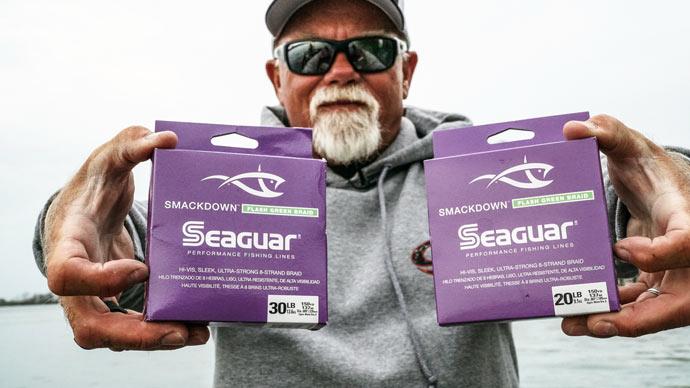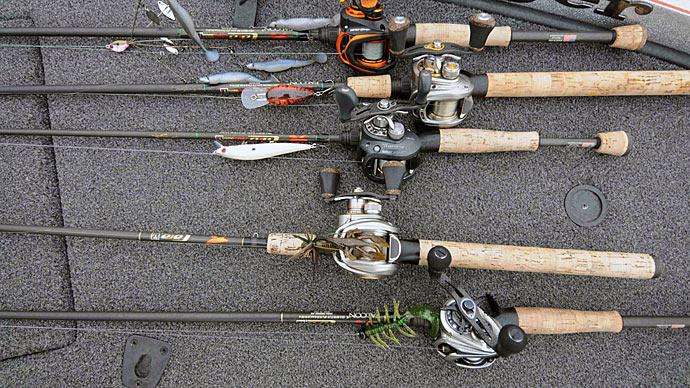
For those of you who feel as though you've come under a full-on advertising assault of the braided vs. monofilament war, you need not feel alone. I empathize! For the last five or six years, the amount of line options available to the bass angler has nearly quadrupled, offering claims of unmatched stretch reduction and complete and total indestructibility. Line manufacturers are pouring millions upon millions of dollars into research in a frantic attempt to create and market the next great "super-line." It undoubtedly bears the question, "Which line is right for me"?
We'll start with the basic monofilament line that has been considered the standard since FDR was in power. Monofilament, or "mono," comprises many synthetic components combined in a gel that solidifies into a slick, string-like substance we anglers have come to know and love. For the most part, the procedure of "shooting" the gel through a series of progressively smaller openings while cooling it has remained about the same for nearly half a century. Only in the last decade that true quantum leaps have been made in the composition and production of this product.
Before we go on, allow me to dispel a rumor immediately. Every monofilament line is not the same! A spool of 10-pound test from Company A can be drastically different from Company B. It differs in line diameter, shape, and overall handling. Those of you, who stick religiously to one brand of line and have used another in a pinch, can vouch for the fact that there is a definite difference.
We'll start with diameter. Packaging that advertises "super-thin" will render an instant sale, but are "thin" lines thinner? There is a small decimal number on nearly every package of line right next to the pound test number. That number denotes in millimeters (actually tenths or hundredths of a millimeter) the average thickness of that line. If thin is genuinely what you want, then select a pound test that suits you, then set out comparing the millimeter numbers to find the thinnest line.
Next comes the issue of stretch. As of late, "line stretch" has been banished from nearly every brand of line and replaced by the words "ultra-low-stretch" or "no-stretch." Judging from the sales returns, anglers can't get enough of these lines. The wave of low-stretch monos fill store shelves. They openly boast firmer, stronger hook-sets and fewer lost fish, and most of all, greater overall sensitivity. While this is very true, is some stretch better than no stretch at all? I feel yes.
Yes, for two reasons. Number one, some stretch provides shock absorption that can be an angler's best friend in some circumstances. For example, a fish makes a last-minute run near the boat when only a very short line is out. That line stretch will buy you those precious extra few seconds to get to the bail or the spool release to let some line out, thus avoiding the one-that-got-away story.
Number two, in my opinion, stretch enhances the action to specific lures such as crankbaits. Example: A wide wobbling, diving crankbait fished on stretchless piano wire-type line will noticeably lose some of its "bass appeal" because it will look like it's being dragged through the water rather than swimming.
Keep in mind the shape of the line plays an essential part in its casting and handling. For the most part, even today, the monofilament line is a perfect circle when viewed head-on. However, several line companies are experimenting with flattened, fly line-type line shapes that, when viewed head-on, will look like a wide tapering oval. I have used one of these lines on a trial basis, and I can tell you it does not cast farther or more accurately. However, it lays much nicer on a spool and reduces backlashes. It will also lay higher out of the water, just like its fly line companion, and drastically take depth off of any subsurface rig known to man. Topwater lures and this type of line are perfect bedfellows! From the way it lays on the water to the way it stays out of the hooks of the topwater plug, I would take it over conventional spherical monofilaments any day.
As for handling, that's a personal choice that can only be made by trial and error. When a line feels right, or you "like the way it feels," then you've found the line you like. There is a right and wrong brand in very few instances with monos. I will, however, strongly urge you to stay away from the bottom-shelf bargain brands that offer five thousand yards for six bucks. The problem with these lines is usually varying diameters and handling and many nicks and abrasions that break down the strength of the line right out of the package.
I have personally settled upon Gamakatsu's G-Power line and Excalibur Silver Thread. This is because they combine all the elements mentioned above in what I perceive as a "happy medium."
On the other end of the line spectrum falls the braided, "mega-lines" that, for the most part, have been hyped more than a Don King fight in Manhattan. Upon their arrival, they boasted everything from "absolute zero stretch" to complete invulnerability to anything the fish and elements could throw at it, short of a global apocalypse. Granted, they do offer something extraordinary in the form of sheer strength and toughness, but they are not something brand new. Fly fishermen have been using braided lines as backing on their reels for several years. It's only recently become "mainstream" amongst anglers.
It's no secret why it is so tough - all the materials were initially designed to be used as the stitching and reinforcement on bullet-proof vests. The interesting point is that the actual name of the original braid, Spiderwire, is derived from the way it is produced. Like spider weaves silk, braided line is woven using a series of spinnerets, tightly braiding strands of its components together to form a very tight single strand.
Spectra, Specta2000, and Dacron are just a few of the synthetic materials used in the lines on the market. Unlike monofilaments, these lines have a personality all their own when they hit the water.
First off, they float! This will take some getting used to, and in some cases, rigs need to be adjusted to accommodate it. I wouldn't recommend this line for topwater applications. It has a nasty habit of floating back around the lure and fouling the hooks when given slack.
Second, one has to have a keen eye to see when these lines deteriorate. They do not show the "pockmarks" or light-colored slices that appear on old monofilaments. It merely begins to fray and unravel, significantly decreasing the overall strength. Therefore, the line should be given a quick visual once-over while reeling it in and a thorough inspection near the last five or six feet. Also, a quick look at the knot wouldn't hurt either.
Braided line does have their applications. It's perfect for flipping and pitching. You will be grateful for its pure strength when it comes time to horsing hawgs out of some truly nasty cover. You can rest assured that the chances of this line being abraded from contacting vegetation, provided you are not fishing razor blade plants, are minimal. However, braid doesn't hold up so well in rocks, which can nick and fray the line. Braid also tends to dig into woody cover such as stumps and logs.
I suggest taking your time with line selection, giving each a fair chance, and using what you are comfortable with. Only then will you be performing at your very best. And remember, The line is the only link between you and the fish!




